
table of contents
- Verbena
- Finger bush
- hibiscus
- Hydrangeas
- Small-leaved autumn lilac
- Butterfly lilac
- Clematis
- Winter jasmine
- Winter snowball
A beautiful garden comes into its own when it is adorned with a magnificent sea of flowers. Numerous plants are suitable for this, such as flowering shrubs. Some of them not only convince with a colorful, but also a very long flowering time. You can find out which flowering shrubs bloom particularly long in this article.
Verbena
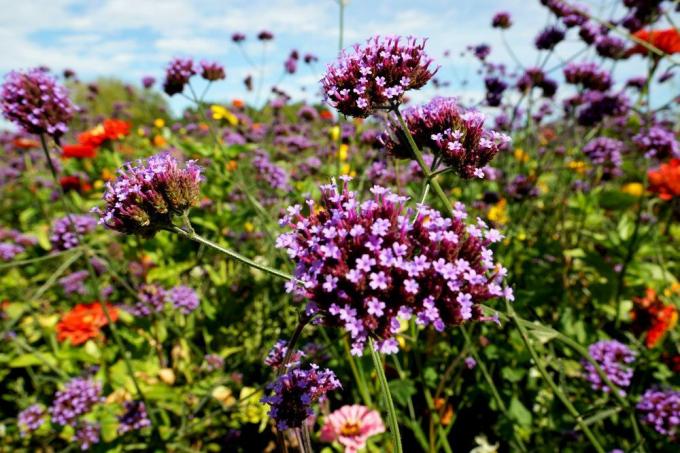
Verbena is spread all over the world and is also increasingly being planted in local gardens. The shrub forms slender flower stalks and requires little space, which is why it is also suitable for smaller gardens. It is important that it is planted in a sunny to partially shaded location. With regard to the soil, the shrub prefers a fresh, sandy to loamy subsoil with a neutral pH value. The verbena flowers for a long time, namely all summer until October. The color of the flowers depends on the variety, because the flowering shrubs can have not only single-colored, but even multi-colored flowers.
- Botanical name: Verbena
- Synonyms: Verbena
- Flower color: purple, green, orange, yellow, red, white, brown, multicolored
- Flowering period: May to October
Note: The verbena attracts numerous butterflies.
Finger bush
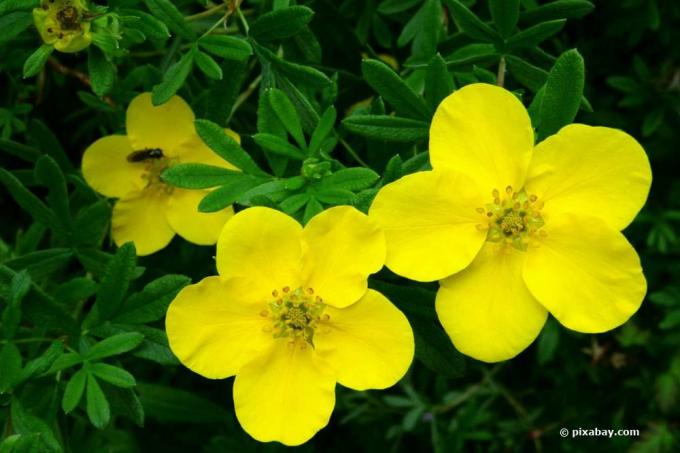
Of the Finger bush In the wild, it grows preferably in dry and moist locations, and is mainly found on mountain slopes. In local regions the finger shrub gets along very well and is considered to be very undemanding. In the garden it feels particularly comfortable in a sunny or slightly shady location, preferably in light soil. The finger shrub can be planted alone or in groups as well as in beds together with roses, sunflowers or junipers. When properly cared for, the finger shrub impresses with its strong flowering and blooms long into October.
- Botanical name: Potentilla fruticosa
- Synonyms: shrub cinquefoil
- Flower color: yellow, white, pink or red
- Flowering period: May / June to October
hibiscus
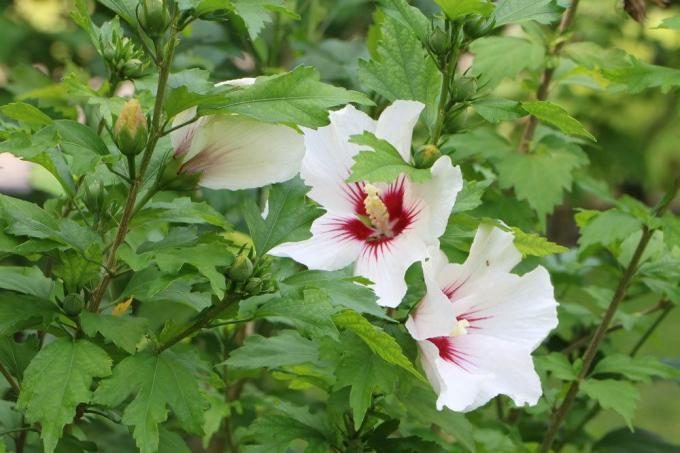
Of the hibiscus there are more than 100 species worldwide, some of them can be grown as shrubs in the garden without any problems. This requires a fully sunny and protected location, such as a place near the terrace. The shrub prefers fresh, dry and well drained soil and flowers for a long time. In order for the hibiscus to have numerous flowers, it should receive sufficient nutrients, otherwise the flower formation will suffer.
- Botanical name: Hibiscus
- Flower color: white, pink, red, multicolored
- Flowering period: July to October
Hydrangeas

Hydrangeas are flowering shrubs that can be planted both in the garden and on the balcony. There they adorn the site with their intensely colored flowers until September. The flower color varies depending on the variety and ranges from blue to pink to purple or white. However, the hydrangea only bears blue flowers if the pH value of the soil is below 5. The plants are visually convincing, but should be consumed with caution in the case of known skin allergies, as they can exacerbate them.
- Botanical name: Hydrangea
- Flower color: blue, pink, purple, white
- Flowering period: June to September
Note: The hydrangea develops its flowers on the shoots from last year, which is why only the faded inflorescences should be cut.
Small-leaved autumn lilac
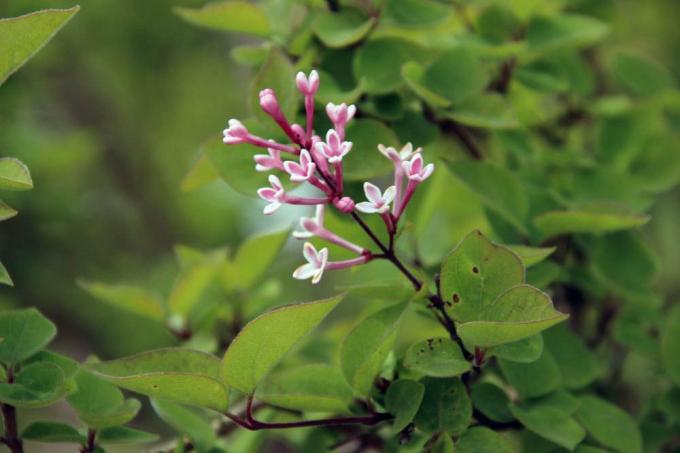
The small-leaved autumn lilac is one of the most popular flowering shrubs, and rightly so: it forms a multitude of pink or purple flowers that adorn the home garden until autumn. The fragrant, intense fragrance is also typical of the lilac blossoms. For optimal growth, fertile soil is required, which ideally is slightly acidic to alkaline and moderately moist. The small-leaved autumn lilac reaches a height of about 1.5 meters and is therefore also suitable for small gardens. It can also cope with urban conditions without any problems, as it can easily survive periods of drought and heat.
- Botanical name: Syringa microphylla
- Synonyms: autumn lilac
- Flower color: purple, pink
- Flowering period: May to October
Butterfly lilac
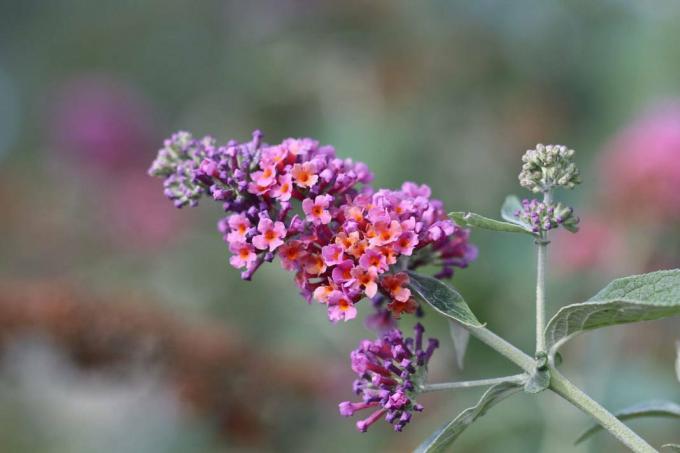
Of the Butterfly lilac is a fast-growing flowering shrub that can reach a height of up to five meters. However, it grows very compactly, so that it also fits into smaller gardens and is also suitable for planting on flower beds. When properly cared for, the shrub forms a multitude of intensely colored flowers that bloom well into autumn. These vary in color, depending on the variety, from purple and pink to blue and white.
- Botanical name: Buddleja davidii hybrids
- Synonyms: butterfly bush, buddleia
- Flower color: purple, pink, white, red
- Flowering period: June to September / October
Note: The butterfly lilac not only attracts butterflies, but also many other useful insects, such as bees.
Clematis
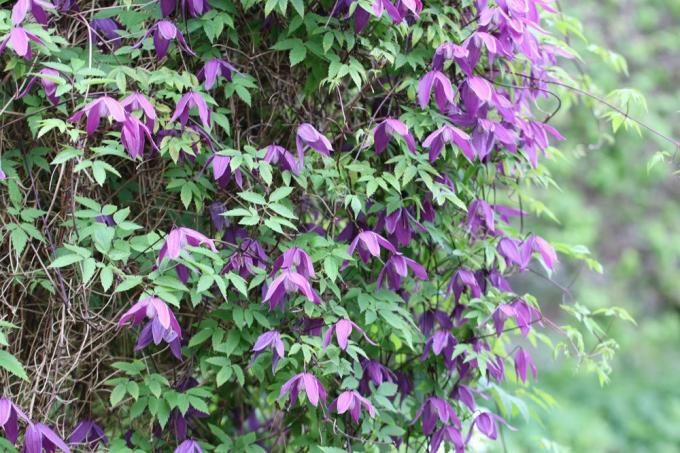
Of the Clematis there are around 300 species, many of which are cultivated as ornamental plants. The reason for this is, among other things, their beautiful flowering, which takes place in May and June. The clematis may even bloom a second time in August and September. Some varieties of clematis generally even bloom for a very long time, such as "Betty Corning" or "General Sikorski". In order for the clematis to bloom for a long time, it is necessary to have good exposure, as well as a strong pruning.
- Botanical name: Clematis
- Flower color: blue, red, purple, green, yellow, white, cream colored
- Flowering period: May and June, August and September
Winter jasmine
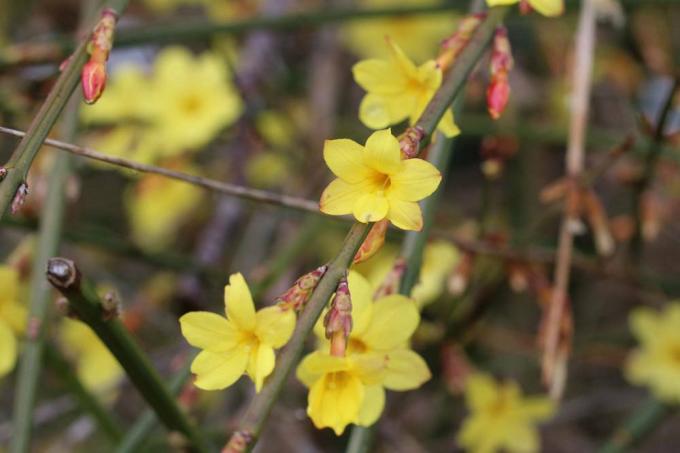
A colorful sea of flowers in winter is also possible, like the one Winter jasmine proves. Because the shrub bears its flowers from December / January to March / April. The flowers of these flowering shrubs are bright yellow and are ideal both in the garden and in a tub on the balcony. It is important that the flowering shrubs are placed in a sunny to partially shaded location. They are considered to be hardy because their buds can withstand temperatures down to -15 degrees Celsius, but their flowers are quite sensitive to frost.
- Botanical name: Jasminum nudiflorum
- Synonyms: Bare-flowered jasmine, yellow winter jasmine, real winter jasmine
- Flowering period: December / January to March / April
- Flower color: yellow
Note: The winter jasmine is one of the few representatives of this plant whose flowers are not fragrant.
Winter snowball

Of the Winter snowball Not only does it bloom for a long time, but also over the winter! The shrub forms its pink flowers from November and carries them until March / April. The flowers not only bring color to the home garden, but also impress with their strong scent. Although the winter snowball blooms in the cold season, it prefers warmth and lots of sun. Accordingly, it feels most comfortable in a sunny to partially shaded location. In relation to the subsoil, a loose, permeable and nutrient-rich soil with a pH value between 5.5 and 8 is optimal for the shrub.
- Botanical name: Viburnum bodnantense
- Synonyms: Bodnant snowball, scented snowball
- Flower color: pink
- Flowering period: November to March / April
Note: The winter snowball can be planted both as a solitary plant and in groups of shrubs. It goes perfectly with flowering shrubs such as lilac or forsythia.



